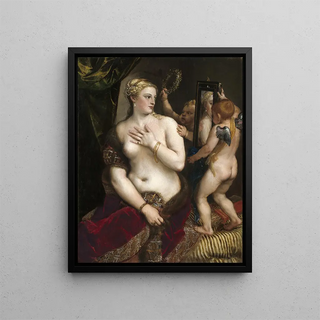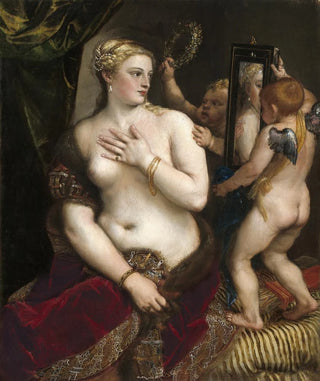Art print | Venus at her mirror - Titian


View from behind

Frame (optional)
In the world of Renaissance painting, few artworks manage to capture the essence of female beauty with as much grace and depth as "Venus at her Mirror" by Titian. This iconic piece, created in the 16th century, embodies not only the ideal of classical beauty but also evokes timeless themes such as desire, reflection, and sensuality. The scene depicts the goddess Venus, a central figure in mythology, gazing at herself in a mirror held by a putto, while her gaze appears both contemplative and provocative. The atmosphere of the artwork invites viewers to question the nature of the gaze and perceptions of beauty—a dialogue that still resonates today.
Style and uniqueness of the artwork
Titian's style is characterized by a masterful use of color and light, which gives his works an almost living dimension. In "Venus at her Mirror," warm and rich tones blend harmoniously, creating a sensual and enveloping ambiance. Venus's skin, delicately painted, seems to emit its own luminosity, while the drapery of her garment adds a tangible texture to the composition. The contrast between the dark background and the clarity of the central figure further emphasizes the presence of the goddess. Titian also masters movement, with flowing lines guiding the viewer's eye across the canvas, from Venus's silhouette to her reflection in the mirror. This dynamic is reinforced by the slightly inclined posture of the goddess, who, while both passive and active, seems to invite the viewer to share this moment of introspection.
The artist and his influence
Titian, whose real name is Tiziano Vecellio, is one of the most influential artists of the Venetian Renaissance. His career spans several decades, during which he evolved and adapted to the trends of his time while maintaining a strong artistic identity. His innovative approach to color and light not only redefined painting of his era but also paved the way for future masters such as Rubens and Rembrandt.

Matte finish

View from behind

Frame (optional)
In the world of Renaissance painting, few artworks manage to capture the essence of female beauty with as much grace and depth as "Venus at her Mirror" by Titian. This iconic piece, created in the 16th century, embodies not only the ideal of classical beauty but also evokes timeless themes such as desire, reflection, and sensuality. The scene depicts the goddess Venus, a central figure in mythology, gazing at herself in a mirror held by a putto, while her gaze appears both contemplative and provocative. The atmosphere of the artwork invites viewers to question the nature of the gaze and perceptions of beauty—a dialogue that still resonates today.
Style and uniqueness of the artwork
Titian's style is characterized by a masterful use of color and light, which gives his works an almost living dimension. In "Venus at her Mirror," warm and rich tones blend harmoniously, creating a sensual and enveloping ambiance. Venus's skin, delicately painted, seems to emit its own luminosity, while the drapery of her garment adds a tangible texture to the composition. The contrast between the dark background and the clarity of the central figure further emphasizes the presence of the goddess. Titian also masters movement, with flowing lines guiding the viewer's eye across the canvas, from Venus's silhouette to her reflection in the mirror. This dynamic is reinforced by the slightly inclined posture of the goddess, who, while both passive and active, seems to invite the viewer to share this moment of introspection.
The artist and his influence
Titian, whose real name is Tiziano Vecellio, is one of the most influential artists of the Venetian Renaissance. His career spans several decades, during which he evolved and adapted to the trends of his time while maintaining a strong artistic identity. His innovative approach to color and light not only redefined painting of his era but also paved the way for future masters such as Rubens and Rembrandt.






